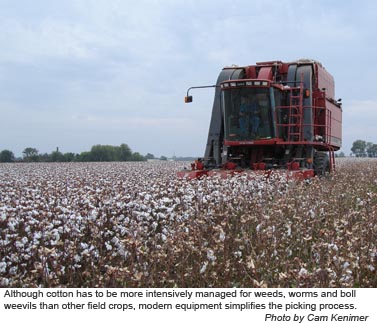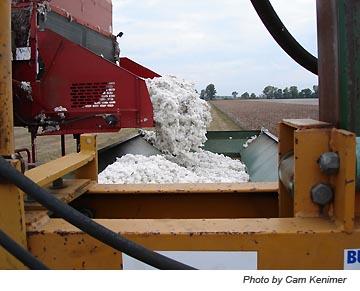Cotton Making Comeback in Western Kentucky
Cotton Making Comeback in Western Kentucky

Few people think of Kentucky when they think about cotton farming. But cotton was grown in the far western part of the state for many years and, recently, it has begun making a comeback of sorts. A handful of farmers have returned to the crop for a second year with nearly 3,000 acres planted in Fulton County in 2006.
“Cotton was grown here for years and years and years, but it went out in the 1970s,” said Cam Kenimer, the county’s agricultural and natural resources agent with the University of Kentucky Cooperative Extension Service. “At that time many were still picking it by hand, and what automated pickers were available were pretty primitive.”
Prices and yields dropped on cotton in the '70s, while corn and soybean production took off. Farmers throughout the state abandoned cotton and began growing grains instead.
“We had a bad year that year and we switched to soybeans,” said Fulton County farmer Joey Parker, whose family quit growing cotton in 1973. “Cotton was very labor intensive. At the time we had a one-row picker and also picked by hand. It was a very labor intensive crop, and we had no chemicals either.
“Cotton genetics have improved, so now it is easier to raise it, and with the high price of nitrogen for corn and the price of soybeans, it’s just another alternative crop,” added Parker, who remembers taking naps on his mother’s cotton bag while she picked.
Nitrogen fertilizer prices have increased about 280 percent in the four years Kenimer said he’s been in Fulton County.
Parker, one of the farmers from Kentucky and Tennessee who grow cotton in Fulton County, was finishing up his harvest last week after being delayed by fall rains. At harvest, the cotton is put into bales weighing about 500 pounds. The bales are placed into a module and then picked up and transported to a cotton gin in Tiptonville, Tenn., about 18 miles away.
“We tried some cotton last year and it turned out good so we added acres and bought equipment,” Parker said. “Prices are not great but you can make some money. You can easily put $300 to $350 per acre into it but you can get back $600 to $700 and, if you have a really good crop, even more.” Although cotton has to be more intensively managed for weeds, worms and boll weevils than other field crops, modern equipment has made the picking process easier, Kenimer said. Local growers have signed on with the Tennessee boll weevil eradication program and have their crops scouted weekly, he said. It only takes a few of the weevils to devastate a cotton crop.
Although cotton has to be more intensively managed for weeds, worms and boll weevils than other field crops, modern equipment has made the picking process easier, Kenimer said. Local growers have signed on with the Tennessee boll weevil eradication program and have their crops scouted weekly, he said. It only takes a few of the weevils to devastate a cotton crop.
Kenimer admits he knows little about cotton production, but with its resurgence into the county he is trying to learn as much as he can. He also calls on a colleague from the University of Tennessee Extension service when he needs some expertise.
It’s unclear whether more farmers in Fulton County will add cotton to their operations, especially in light of the strong price outlook for corn. But Kenimer said those already in will likely stay until cotton prices take a tumble.
“It may be something people inch into,” Parker said. “With the prices of corn and soybeans up, I don’t look for a whole lot of change right now.
“It’s been a good experience,” he added. “I always said I’d never go back into the cotton fields again, but sometimes you have to eat your words.”
